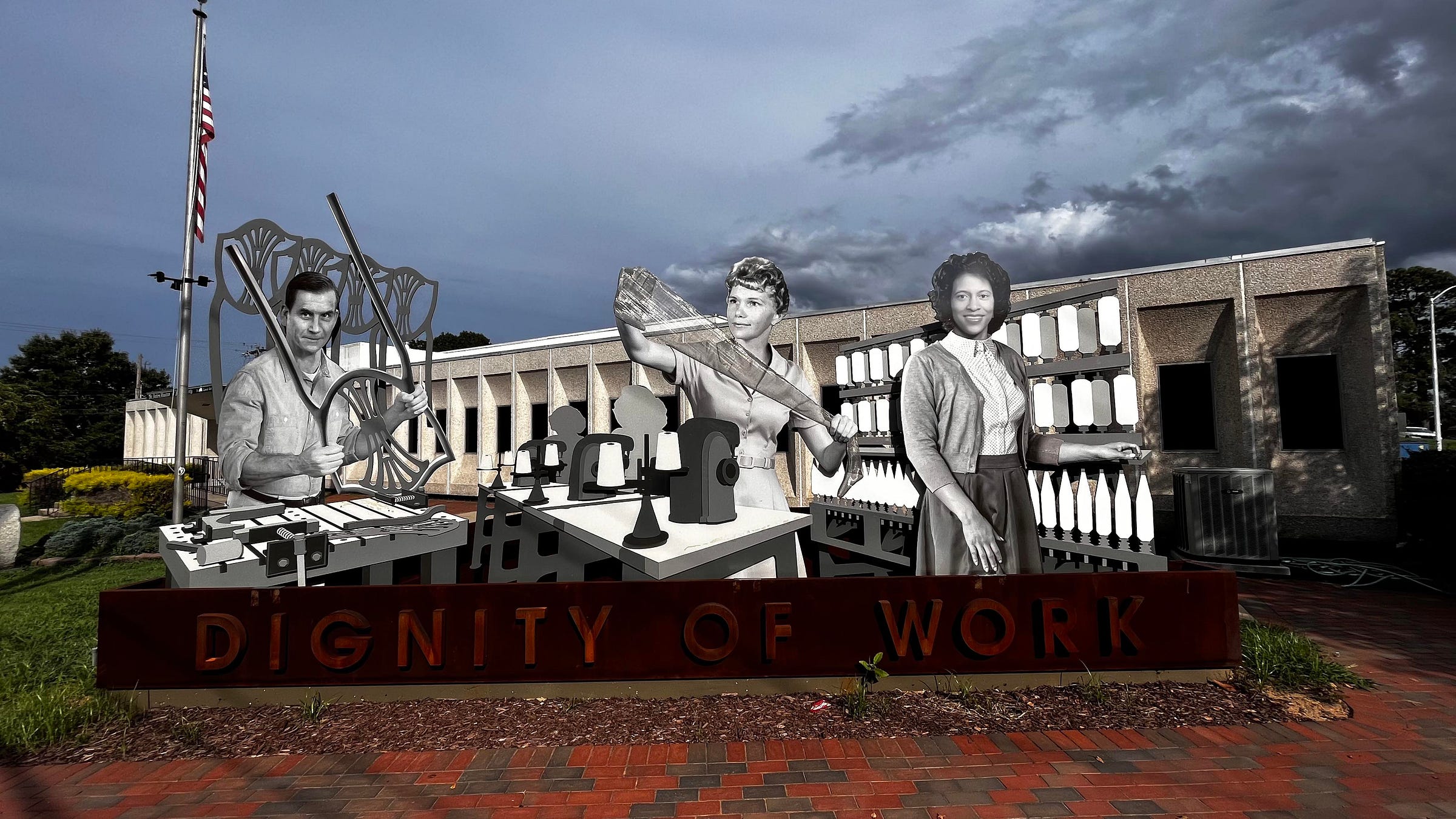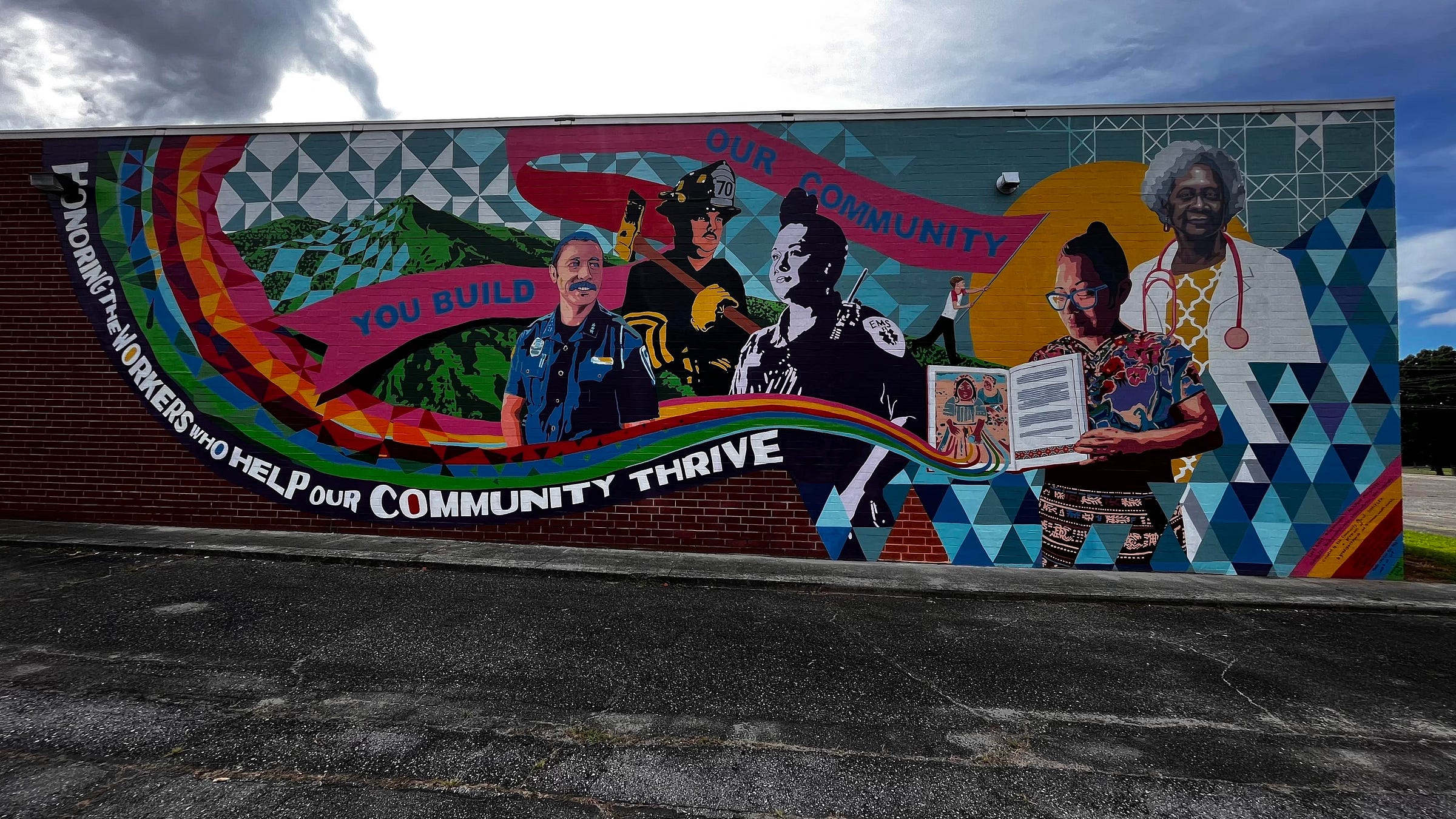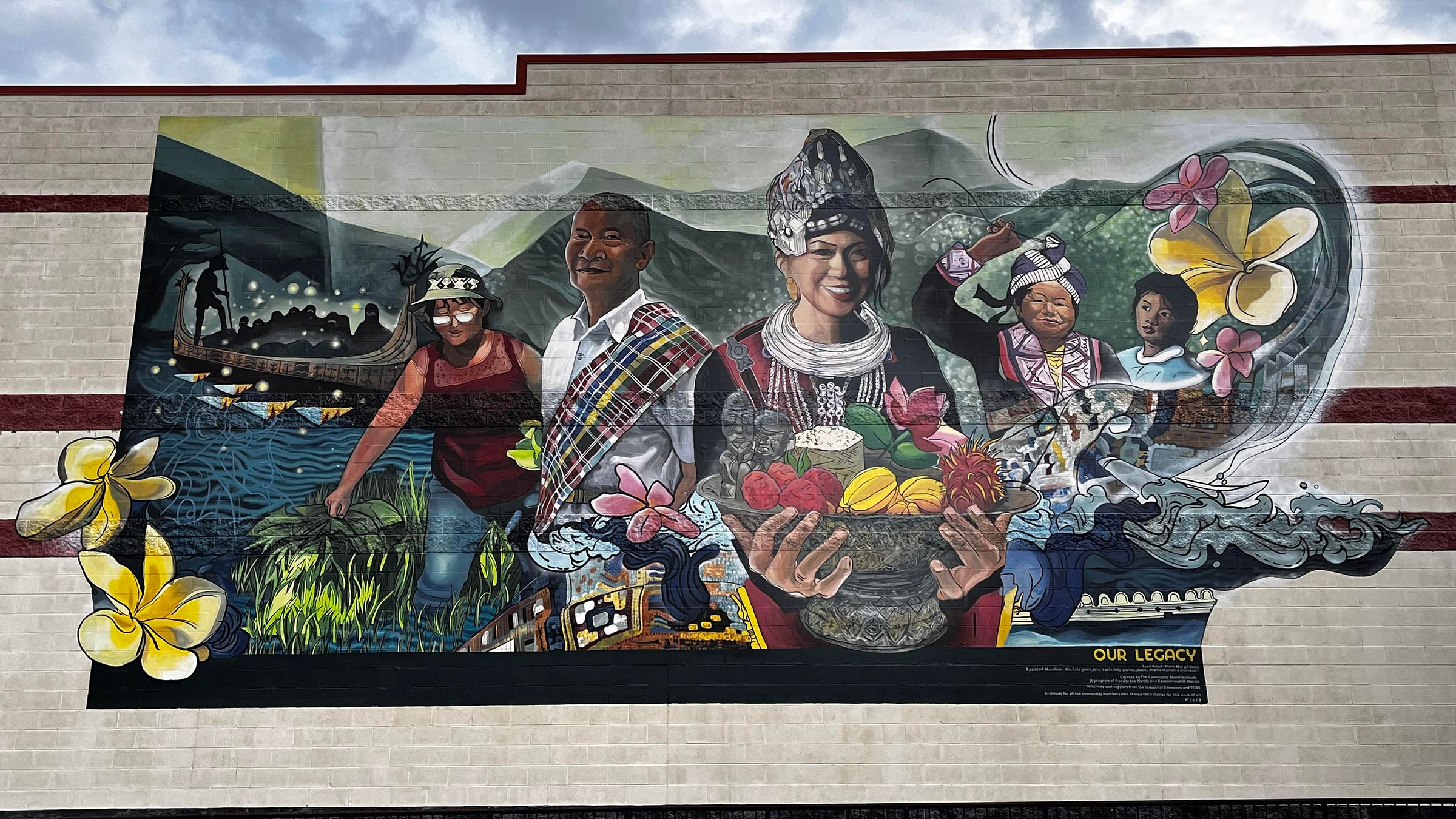Morganton Signals Support for Inclusion and Worker Solidarity
Three new murals and a monument to "The Dignity of Work" make strong statements about which values Morganton residents want to represent their community.

MORGANTON, North Carolina—We rely on public spaces to shape and reinforce our deepest values, who we are as a community.
And Morganton is making concrete statements as to what those values are.
In the past few months, “Nature’s Playground” has seen the addition of multiple murals and a new monument sending a clear message to residents and visitors to the Foothills: this is a place that values worker solidarity and the inclusion of all voices that have contributed to our community.
In word and art, at least.
A Monument to the ‘Dignity of Work’
The Dignity of Work Monument was dedicated in May. Located on the lawn outside the Burke Museum of History, the monument was sponsored by the Workers’ Legacy Foundation (WLF).
A Morganton-based organization founded by Jim Warlick, WLF is on a mission to “tell the stories and honor the children, women, and men of Burke County, North Carolina who worked in the textile and hosiery mills and furniture factories, desiring a just and rewarding life for their families while building good and strong communities.”
The 22-foot long by 10-foot high Dignity of Work Monument includes vignettes featuring three workers who labored in Burke’s traditional industries.

When you look at the monument, you’ll encounter three glowing faces staring back at you:
Claude Moore, a furniture worker
Mary Warlick, a hosiery worker (Jim’s mother)
Anne Ramsuer, a textile worker
While elsewhere in Morganton activists labor to remove a monument to white supremacy and the Confederacy, it’s refreshing to see a permanent installment dedicated to working-class icons, as the monument’s designer Joe Wider describes them.
“These people are really, truly heroes,” Wider told The Paper. “We don’t think of them as that, because they’re never given any celebrity value, so we thought, with Jim’s input and inspiration, let’s make these people the heroes they are today.”
It’s difficult to discern to what degree the creation of this monument reflects a genuine commitment to worker solidarity and how much of it is motivated by a desire to more broadly celebrate the history and heritage of those who have come before us.
I wonder if many will see it as a message of solidarity with workers. Nonetheless, it’s leaving an impression already.
“The impact of this monument did not really hit me until I stood squarely in front of it,” says Bill Poteat, editor of The Paper and the child of local mill workers. “And I knew that this monument represents my family. It represents my roots, and in so many ways, it represents the man I am today.”
Tributes to Essential Workers, Southeast Asian Americans, and African Americans in Burke County
Completed the last weekend in July, three new Morganton murals are the fruits of a collaboration between TOSS (the Old School Studio), the Industrial Commons (TIC), and the Community Mural Institute (CMI).
A formerly independent art education group, TOSS integrated in 2021 with TIC, a nonprofit dedicated to “rebuilding a diverse working class based on locally rooted wealth.” CMI is a partnership between GoodSpace Murals, a woman-powered community public art studio, and Common Wealth Murals, an organization that offers “intensive training for artists and emerging muralists to learn techniques for community-engaged mural creation.”
Notably, CMI boasts a diverse group of established artists, including 60% who identify as BIPOC (Black, Indigenous, and people of color) or women.
Roughly two years in the making, these murals can be found in 3 locations:
Essential Workers (The Industrial Commons, 647 Hopewell Road)
Southeast Asian Americans (Marquee Cinemas Mimosa 7, 101 S. Green St.)
African Americans (Play Again Therapy, 205 S. Sterling St.)
(The process of bringing these community-oriented murals to life has thoughtfully been detailed by Angela Kuper Copeland in The Paper.)
Southeast Asian American Mural
Designed by Kiana Mui, the Southeast Asian American Mural is intended to evoke a sense of “cultural connectivity,” and features themes of exodus, assimilation, and collective resistance.
Figures in the mural are inspired by Chue and Tou Lee, Thoum Nivanh, Pa Nhia Thao, Mai Vue, and Dayna Yang.
Essential Workers Mural
Highlighting the sacrifices and travails so many educators, medical professionals, and first responders have made in our Appalachian community, the Essential Workers Mural is meant to show how foundational these people are to our shared success.

Designed by Ian Brownlee, the mural’s figures include Carol Largent Ervin, Izabela Pablo Pedro Peeler, Keith Bowman, Ashleigh Taylor, and Josh Benfield.
African American Mural
The African American Mural details historic local events, including the flooding of the Fonta Flora Community, desegregation, and musical and athletic contributions from Black folks in Burke County.

Designed by Darlene J. McClinton, this mural is a triumphant contrast in defiance of the Confederate monument that can be seen several hundred yards due west on the Historic Burke County Courthouse lawn.
Does Morganton Genuinely Value Inclusion and Worker Solidarity?
It remains to be seen what conversations these installments will provoke within the Morganton community, let alone the social and political ramifications, but their prominence should enliven those who advocate for a more egalitarian and forward-looking Burke County.
At the least, they should serve as a palate cleanser of sorts for the two Confederate flags people are forced to stomach as they enter Burke County on I-40, from either direction, and offer a countervailing flavor to the continued presence of a Confederate statue on Morganton’s most prominent lawn.
Changes are coming to the Foothills of the Blue Ridge Mountains. Important voices are rising up in Appalachia.
But, will oppressive murmurs snuff them out, or are we seeing momentum multiply for the historically marginalized and economically overlooked?


